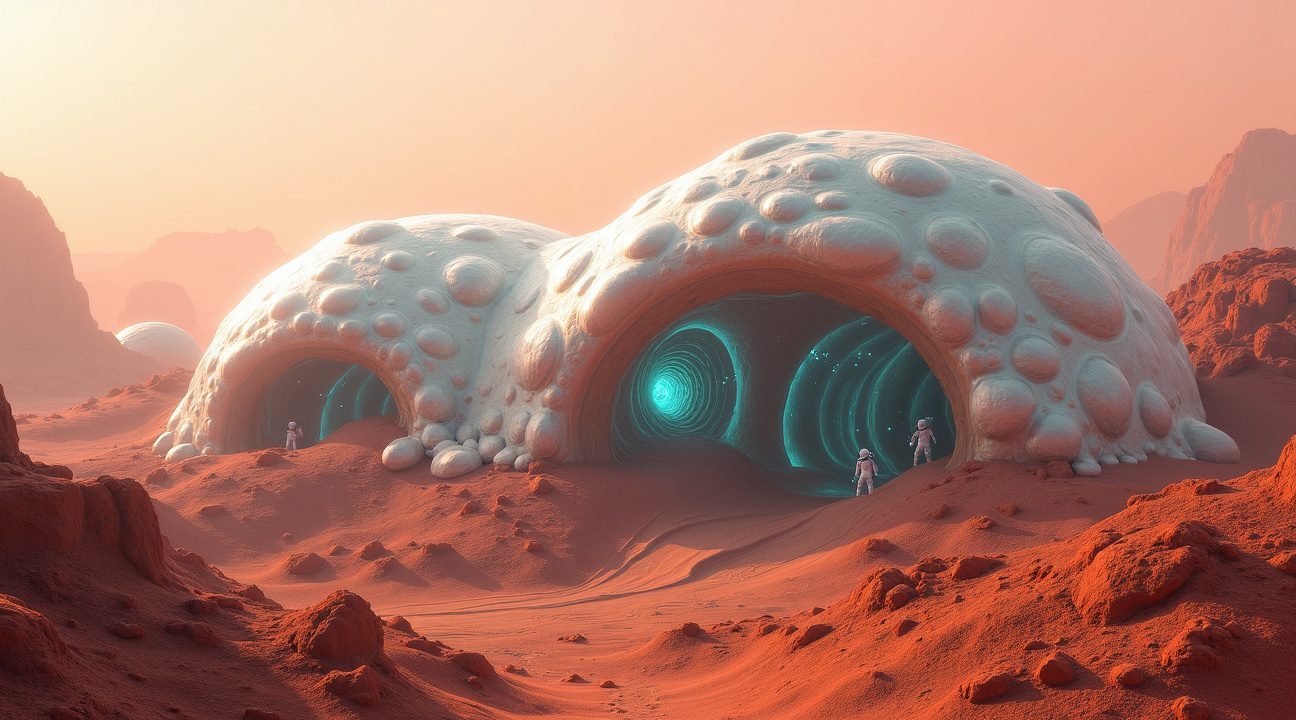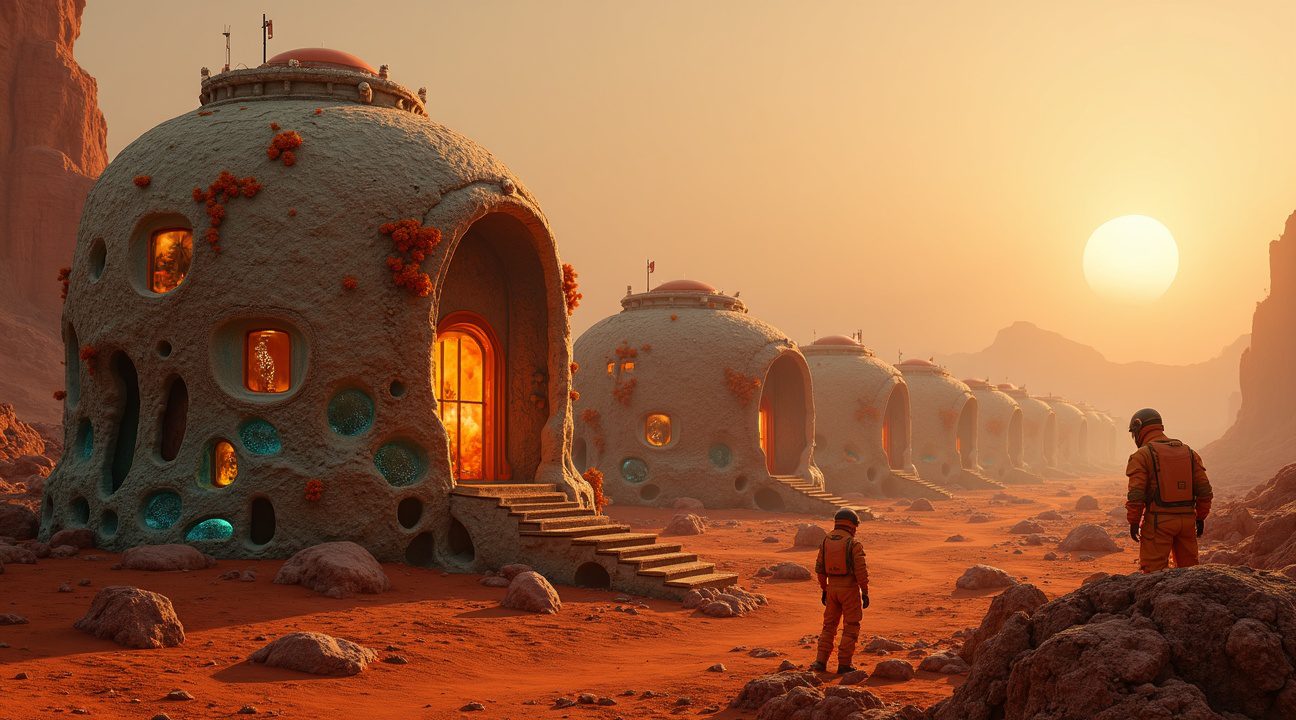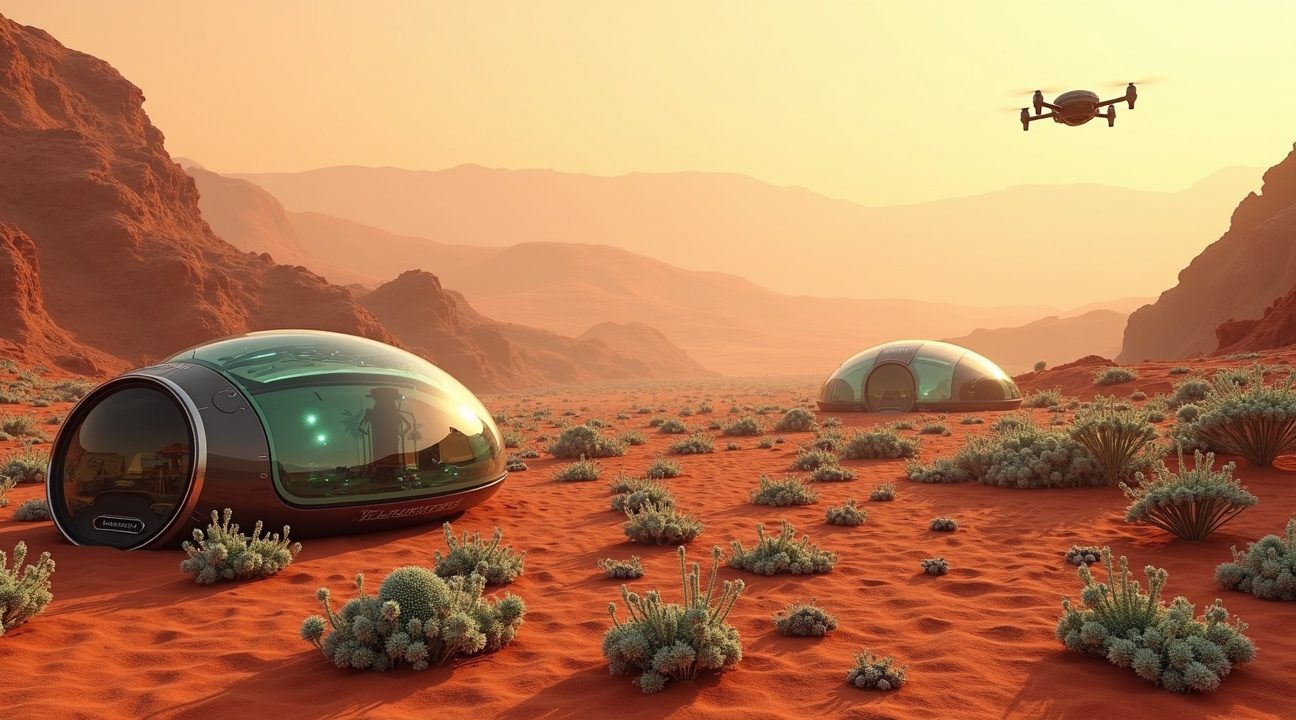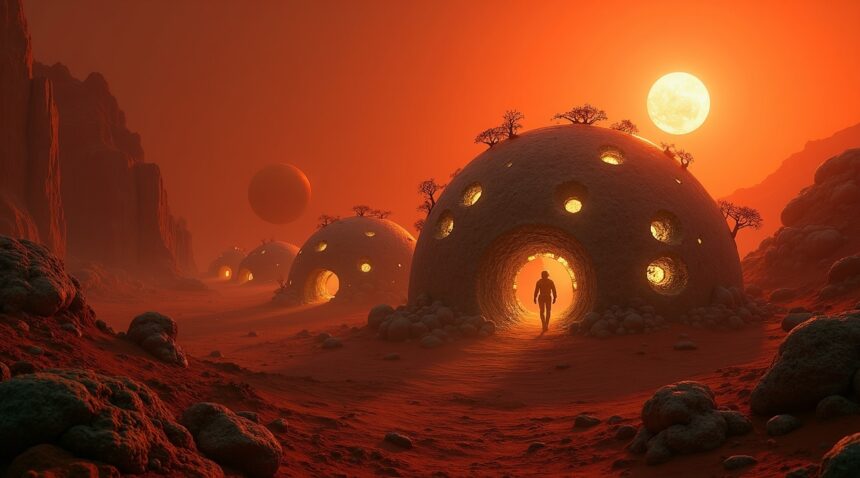Scientists have uncovered incredible extremophile fungi that can survive in Mars-like environments and even generate oxygen, marking a potential leap forward in the quest to colonize the Red Planet.
Key Takeaways
- Extremophile fungi survive Mars conditions – Rhinocladiella similis and related species endure toxic magnesium perchlorate and intense UV-C radiation by producing melanin shields for protection.
- Biological partnerships create oxygen – Fungi and cyanobacteria collaborate to convert Martian CO₂ and regolith into breathable oxygen while purifying the air of metallic toxins.
- Self-growing habitats using fungal networks – NASA’s myco-architecture research enables spores to be sent to Mars and activated with water to grow livable structures.
- 3D printing with living materials – Engineers utilize regolith-based inks containing microorganisms for self-repairing and adaptive building materials.
- Accelerated colonization timeline – These systems may allow atmospheric pockets to form in just 10–15 years, significantly accelerating colonization efforts.
The Discovery That Changes Everything
Mars is among the most inhospitable terrains known. From sub-zero temperatures plummeting below -80°F to extremely high radiation and toxic surface chemicals like perchlorates, conditions are lethal to typical life forms from Earth.
However, researchers have found that *Rhinocladiella similis* challenges these limits. This fungus produces melanin, which acts as a natural barrier against ultraviolet and cosmic radiation. More remarkably, it survives and reproduces in perchlorate concentrations that are deadly for most Earth microbes.
In controlled experiments simulating Martian conditions, these fungi not only survived but actively generated oxygen, retaining their metabolic functions even under extreme stressors. This discovery offers profound implications for in-situ life support on Mars.
How Fungal-Bacterial Partnerships Work
The synergy between extremophile fungi and cyanobacteria is vital. Cyanobacteria are efficient at photosynthesis but are vulnerable to radiation. The fungi shelter them, and in return, receive organic nutrients and oxygen produced through photosynthesis.
This results in a mutual ecosystem where fungi process Martian toxins and shield their bacterial partners while the bacteria transform Martian CO₂ into oxygen. Over time, this partnership develops into a self-sustaining system that supports life independently.
Benefits of the Partnership Include:
- Natural radiation protection through melanin production by fungi.
- Efficient oxygen generation managed by cyanobacteria photosynthesis.
- Metal detoxification from Martian regolith thanks to metabolic processing.
NASA’s Myco-Architecture Revolution
NASA has pioneered innovative applications of fungal biology with a concept known as myco-architecture. This involves transporting dormant fungal spores on missions. Upon arrival and hydration, these spores grow into dense networks forming solid, livable structures.
Programs like NASA’s Myco-architecture project demonstrate that these fungal systems can be engineered to follow set patterns, controlled through nutrients and environment factors. These structures are not only scalable and space-efficient but also self-healing, responding to damage by generating new growth automatically.
Living Building Materials Transform Construction
Traditional construction on Mars poses logistical and financial hurdles. Sending construction materials is both expensive and impractical. Innovative approaches using regolith-based biological inks reduce the dependency on Earth-supplied infrastructure.
3D printers equipped with these bio-inks construct walls and structures from local Martian materials mixed with microorganisms. These microbes continue to live within the materials, fortifying them over time and adapting to changes such as radiation and temperature stress.
Material Adaptations Include:
- Radiation shielding activated by microbial pigmentation.
- Thermal regulation adjusted via microorganism behavior.
- Structural reinforcement through ongoing microbial bonding processes.
Atmospheric Transformation Timeline
Unlike traditional terraforming methods that envisioned global-scale intervention over centuries, this biological approach advances localized atmospheric processing within mere decades. Fungal-bacterial systems can establish breathable microenvironments in 10–15 years.
Expansion occurs progressively — localized pods of life begin indoors or in greenhouses, then expand outward as biological networks stabilize and scale. Within several decades, expansive habitable zones could stretch across Mars’s surface.
Technical Challenges and Solutions
Though promising, these methods face technical obstacles:
- Spore viability – Maintaining fungal integrity during long-term space travel requires advanced storage techniques that preserve functions during 6–9 months of interplanetary transit.
- Water scarcity – Mars lacks abundant water. Scientists have designed closed-loop water systems for efficient growth with minimal hydration.
- Thermal fluctuation management – Organisms must endure temperature extremes. Research into genetically resilient strains and engineered thermal systems is ongoing.
Integration with Human Settlement Plans
These biological ecosystems are not replacements but complements to early-stage human infrastructure. Traditional life support systems will still be essential initially. However, biological systems act as a safety net.
If mechanical systems fail, fungal and cyanobacterial colonies can continue producing oxygen and clean air – potentially saving lives. Over time, as these systems scale, astronauts and settlers can transition away from Earth-reliant support entirely.
Future Research Directions
Scientists are currently focused on improving several areas:
- Oxygen output enhancement to meet human respiratory needs.
- Radiation and cold tolerance improvements using refined genetic engineering.
- Field deployment simulation to enable real-world testing before actual mission integration.
Efforts continue to bridge laboratory results with practical, scalable applications in extraterrestrial habitats. These pioneering fungal systems symbolize a transformative shift—from passive survival to active biosphere creation in space environments.
For further exploration of NASA’s research in this field, you can read more on the NASA Myco-architecture initiative.
Extremophile Fungus Survives Mars-Like Conditions and Produces Protective Molecular Shield
The black fungus Rhinocladiella similis stands as a remarkable extremophile organism that demonstrates extraordinary resilience under conditions mimicking the harsh Martian environment. This fungus can withstand high concentrations of magnesium perchlorate, a toxic salt abundant in Martian regolith, while simultaneously enduring intense UV-C radiation that would prove lethal to most Earth-based life forms.
Cellular Transformation and Defense Mechanisms
When exposed to Mars-like conditions, R. similis undergoes a fascinating cellular transformation that shifts the organism into a yeast-like form. Proteomics and metabolomics studies reveal this morphological change triggers a cascade of protective responses within the fungus. The organism significantly increases production of melanin pigments, creating a biological armor that serves multiple protective functions.
The melanin shield operates through several key defense strategies:
- Neutralization of harmful reactive oxygen species that could damage cellular components
- Stabilization of cellular membranes in the high-saline perchlorate environment
- Enhanced protection against radiation-induced oxidative stress
- Improved structural integrity under chaotropic conditions
Laboratory research confirms R. similis outperforms other fungal species, including Exophiala sp. strain 15Lv1, when tested for perchlorate tolerance. This superior performance stems from the fungus’s sophisticated molecular defense system that includes upregulated laccase enzymes and increased production of peptidyl–prolyl cis–trans isomerases.
The laccase enzymes play a critical role in the organism’s survival strategy by catalyzing the oxidation of various organic compounds while simultaneously reducing oxygen levels. These enzymes contribute to the fungus’s ability to process toxic compounds found in Martian soil while generating oxygen as a beneficial byproduct. Meanwhile, the peptidyl–prolyl cis–trans isomerases help maintain proper protein folding under the extreme stress conditions present on Mars.
Scientists have observed that the melanin production creates an effective molecular barrier against the chaotropic effects of perchlorates, which typically disrupt protein structure and cellular function in most organisms. The fungus’s antioxidant enzyme systems work in concert with melanin to maintain cellular homeostasis despite the oxidative challenges posed by the Martian environment.
This discovery holds significant implications for future space exploration missions, particularly those focused on Mars colonization. The fungus’s ability to thrive in perchlorate-rich environments while producing oxygen could revolutionize atmospheric processing technologies for the Red Planet. Research into extremophile organisms like R. similis continues to expand our understanding of life’s limits and possibilities beyond Earth.
The transformation process from filamentous fungus to yeast-like form represents an adaptive response that optimizes survival under resource-limited conditions. This morphological flexibility, combined with enhanced melanin production, creates a highly efficient biological system capable of maintaining viability in environments previously thought uninhabitable.
Current studies focus on understanding the genetic mechanisms behind these remarkable adaptations, with researchers examining how the fungus regulates its protective responses. The insights gained from R. similis research contribute valuable knowledge to the broader field of astrobiology and may inform future missions to other celestial bodies where similar extreme conditions exist.
The fungus’s capacity to maintain cellular integrity while actively producing oxygen positions it as a potential cornerstone organism for life support systems in future Mars habitats. Its natural resistance to perchlorate toxicity eliminates the need for extensive soil treatment processes that would otherwise be required to make Martian regolith suitable for biological applications.
Revolutionary Cyanobacteria-Fungi Partnership Creates Oxygen and Cleans Martian Air
Scientists have uncovered a groundbreaking biological system that could transform Mars colonization through a sophisticated partnership between cyanobacteria and filamentous fungi. This symbiotic relationship represents a major breakthrough for sustainable life support systems on the Red Planet, offering both oxygen production and environmental remediation capabilities.
How the Biological Partnership Functions
The cyanobacteria-fungi collaboration operates through an elegant exchange system that maximizes efficiency on Mars. Diazotrophic cyanobacteria capture atmospheric CO₂ and N₂ from the Martian environment, converting these gases through photosynthesis into life-sustaining oxygen and essential organic nutrients. These nutrients then fuel the growth of filamentous fungi, which provide crucial structural and environmental benefits in return.
Fungi play an equally important role by binding harmful metal ions present in Martian dust, effectively cleaning the surrounding air of toxic particles. They also serve as biomineralization sites, where biological processes consolidate loose Mars regolith into solid, stable structures. This dual function addresses two critical challenges for human survival: air purification and construction materials for habitats.
The photosynthetic activity of cyanobacteria creates another advantage by boosting carbonate ion concentrations in the local environment. Their secreted biopolymers form interfaces with Martian dust particles, improving the overall effectiveness of the air cleaning process. This natural filtration system could prove invaluable for maintaining breathable atmospheres in enclosed spaces.
Engineered Organisms and Self-Sustaining Systems
Researchers have identified that microalgae derived from lichens show remarkable promise under simulated Mars conditions. These hardy organisms can photosynthesize effectively in the planet’s challenging environment, producing oxygen while also generating biomass that could serve multiple purposes. Some systems demonstrate exceptional autonomy, requiring only basic inputs to function:
- Martian regolith simulant as a growing medium
- Natural light from the sun
- Simple inorganic liquid nutrients
- Standard atmospheric conditions
Engineered lichen organisms represent another frontier in this biological approach. These modified life forms could contribute significantly to Mars colonization efforts by providing food sources, building materials, and closed-loop life support systems. Their ability to thrive in harsh conditions makes them ideal candidates for establishing sustainable colonies.
The self-sustaining nature of these biological systems offers tremendous advantages for long-term space missions. Unlike mechanical oxygen generators that require constant maintenance and replacement parts, these living systems can reproduce and maintain themselves with minimal human intervention. This autonomy becomes increasingly valuable as missions extend beyond Earth’s immediate support range.
Research into these partnerships continues to reveal new applications for space exploration. The same principles could potentially support commercial space ventures and permanent settlements throughout the solar system. The versatility of these biological systems makes them adaptable to various extraterrestrial environments beyond Mars.
Scientists emphasize that this approach represents more than just oxygen production – it’s a comprehensive solution for creating habitable environments. The combination of air purification, construction material creation, and life support demonstrates how biological systems can address multiple challenges simultaneously. This integrated approach could revolutionize how humans establish and maintain presence on other planets.
Testing continues under increasingly realistic Mars-like conditions, with researchers fine-tuning these biological partnerships for optimal performance. Early results suggest that these systems could begin functioning immediately upon arrival on Mars, providing essential life support capabilities from day one of any mission.
NASA’s Myco-Architecture Plans Self-Growing Mars Habitats Using Fungal Networks
NASA’s groundbreaking myco-architecture research represents a revolutionary approach to building sustainable habitats on Mars. I find this concept fascinating because it addresses one of the most challenging aspects of Mars colonization — creating livable structures without transporting massive amounts of building materials across space.
Transportable Fungal Technology and Multi-Layered Habitat Design
The brilliance of NASA’s fungal habitat system lies in its compact transportability. Structures can be shipped to Mars as dormant spores, requiring minimal space and weight during transit. Once astronauts arrive and add water to these spores, the fungi activate and begin growing into predetermined architectural forms. This approach eliminates the need for heavy construction equipment or prefabricated materials.
NASA’s habitat design incorporates three distinct functional layers that work together harmoniously:
- An outer ice layer provides crucial radiation protection for inhabitants
- A middle cyanobacteria layer performs photosynthesis to generate oxygen and essential nutrients
- An inner fungi layer creates the primary structural framework of the habitat
Each layer serves a specific purpose while contributing to the overall ecosystem. The ice layer shields occupants from Mars’ harsh radiation environment, while the cyanobacteria layer functions as a biological life support system. Meanwhile, the fungal network provides structural strength and can potentially process Martian regolith into usable building materials.
Environmental Safety and Resource Utilization
Environmental protection remains a top priority in NASA’s myco-architecture plans. The mycelial networks are designed with containment protocols to prevent contamination of the Martian environment. These safety measures ensure that Earth-based organisms don’t interfere with potential indigenous Martian life or permanently alter the planet’s ecosystem.
Water sourcing for fungal activation comes directly from local Martian ice deposits, making the system self-sufficient. This eliminates the need to transport water from Earth, significantly reducing mission costs and complexity. The fungi can process local materials, potentially converting Mars dust and regolith into structural components through biological processes.
The mycelial networks offer additional advantages beyond basic shelter construction. They can create interconnected passages between habitat modules, forming underground networks that protect inhabitants from surface hazards. These fungal structures naturally adapt to environmental conditions, potentially self-repairing minor damage and expanding as colonies grow.
This technology could transform how humans establish permanent settlements on Mars. Instead of relying solely on mechanical construction methods, colonists would work alongside biological systems that actively contribute to habitat development. The fungi essentially become living building partners that continue growing and adapting long after initial construction.
The integration of biological and mechanical systems in space exploration represents a paradigm shift in extraterrestrial architecture. NASA’s myco-architecture research demonstrates how Earth’s biological systems can be adapted for survival in alien environments. This approach could accelerate human expansion beyond Earth by creating self-sustaining ecosystems rather than purely artificial habitats.
Future applications might extend beyond Mars to other celestial bodies where fungi could adapt to different environmental conditions. The technology’s scalability means small research outposts could evolve into larger settlements using the same fundamental principles. As commercial space travel becomes more accessible, these biological construction methods could support diverse space-based communities.

3D Printing with Living Microbes Creates Self-Repairing Martian Building Materials
I find the intersection of biotechnology and construction materials fascinating, particularly when researchers from Texas A&M and University of Nebraska-Lincoln push boundaries by developing regolith inks infused with living microorganisms. These teams aren’t just creating static building materials—they’re engineering dynamic structures that grow, repair themselves, and transform the harsh Martian environment into something more hospitable.
The breakthrough lies in their innovative approach to regolith inks, which serve as the foundation for 3D printing on Mars. Rather than relying on traditional construction materials that would need to be shipped from Earth at enormous cost, these researchers harness microbial communities that can thrive using only local Martian resources. I’m impressed by how they’ve created consolidated building materials that don’t simply maintain their structural integrity but actually improve over time through biological processes.
What sets this technology apart is its self-growing capability. The microbial compositions embedded within these printed structures continue developing after construction completes, creating buildings that literally strengthen themselves. This eliminates the need for ongoing maintenance crews or replacement materials, addressing one of the most significant challenges facing Mars colonization efforts.
Living Architecture That Breathes Life Into Mars
The magic happens through a carefully orchestrated partnership between fungi and cyanobacteria. These microorganisms work in tandem to achieve two critical functions: structural support and atmospheric transformation. Fungi provide the framework, creating strong, flexible networks that can withstand Mars’s extreme temperature fluctuations and radiation exposure. Meanwhile, cyanobacteria handle the atmospheric engineering, actively producing oxygen as they metabolize carbon dioxide and other compounds found in the Martian environment.
I’m particularly excited about the self-repair mechanisms these materials possess. When micrometeoroids or temperature stress cause damage to structures, the living components immediately begin rebuilding damaged sections. This biological response system means that:
- Habitat structures maintain their integrity without human intervention
- Oxygen production continues even if portions of the building are compromised
- Material strength actually increases over time as microbial colonies mature
- Resource efficiency improves as the organisms adapt to local conditions
The technology represents a fundamental shift from traditional construction methods to what I call grown architecture. Instead of assembling dead materials into static forms, these researchers have created a system where buildings become living ecosystems that actively contribute to making Mars more habitable.
The implications extend far beyond simple construction. As these structures produce oxygen, they begin transforming the local atmosphere around human settlements. Each building becomes a biological factory, converting the hostile Martian environment into breathable air while providing essential shelter. This dual functionality could accelerate timeline projections for establishing sustainable human presence on Mars.
I see particular promise in how this technology scales. Unlike mechanical systems that require constant maintenance and replacement parts, these biological construction materials become more efficient and effective over time. The microorganisms adapt to local conditions, potentially developing enhanced oxygen production capabilities or improved structural properties as they evolve within their Martian environment.
The research also addresses resource scarcity concerns that have long plagued space exploration missions. By utilizing locally available regolith and atmospheric compounds, these living building materials eliminate the need to transport construction supplies across interplanetary distances. This represents a crucial step toward establishing self-sufficient colonies that can expand without constant supply missions from Earth.
Perhaps most remarkably, these structures could continue growing and expanding their oxygen-producing capacity long after initial construction. As microbial populations flourish, buildings might literally outgrow their original footprints, creating expanding habitable zones that push back against Mars’s hostile environment. This biological terraforming approach could prove more sustainable and cost-effective than traditional mechanical atmospheric processing systems.

Fungal Discoveries Force Updates to Mars Mission Sterilization Protocols
This breakthrough discovery has triggered immediate concerns about planetary protection protocols. I recognize that current sterilization procedures weren’t designed to handle organisms capable of thriving in Martian conditions. The discovery forces mission planners to reconsider fundamental assumptions about Earth life’s ability to survive in extraterrestrial environments.
Revised Sterilization Requirements for Future Missions
Mission engineers must now develop enhanced sterilization protocols that account for fungal resilience. Current heat-based sterilization methods may prove inadequate against these hardy organisms. The following considerations will shape new protocols:
- Extended exposure times at higher temperatures to ensure complete elimination
- Chemical sterilization agents specifically effective against melanin-rich fungi
- Post-sterilization verification procedures using Mars-analog environmental testing
- Redundant sterilization cycles for critical mission components
- Enhanced monitoring systems to detect potential contamination during transport
These resilient fungi could easily hitchhike on spacecraft, potentially establishing colonies on Mars before human arrival. Mars colonization efforts now require careful consideration of preventing accidental terraforming through microbial contamination.
Biomarker Implications for Life Detection Missions
Proteomic studies have identified specific molecular signatures that will revolutionize life-detection strategies. Upregulated melanin production, enhanced antioxidant enzyme activity, and perchlorate-induced proteins serve as clear biomarkers for Mars-adapted organisms. These discoveries inform the design of next-generation rovers equipped with advanced spectrometers capable of detecting these specific molecular signatures.
Space exploration missions will benefit from targeted biosignature detection systems. Rather than searching for generic signs of life, instruments can focus on identifying the specific proteins and metabolites associated with Mars adaptation. This focused approach increases the likelihood of detecting indigenous Martian life while distinguishing it from potential Earth contamination.
The research also strengthens arguments for human colonization by demonstrating Earth life’s remarkable adaptability. Commercial space ventures can leverage this knowledge to develop life support systems that work alongside beneficial microorganisms. These fungi might serve dual purposes: producing oxygen for human consumption while maintaining equipment through their natural cleaning properties.
This discovery fundamentally changes how scientists approach Mars exploration. Future robotic missions must balance the need for sterile conditions with the potential benefits of controlled biological systems. The challenge lies in preventing uncontrolled contamination while harnessing these organisms’ beneficial properties for human missions.
https://www.youtube.com/watch?v=T3X8B3Eh25QYxM
Breakthrough Research Points to Breathable Mars Atmosphere Within Decades
The discovery of extremophile fungi capable of converting Martian regolith into oxygen marks a pivotal moment in space exploration and planetary habitability research. I find this breakthrough particularly exciting because it shifts the timeline for potential human colonization from centuries to mere decades, fundamentally changing how we approach Mars mission planning.
These hardy microorganisms possess survival mechanisms that allow them to thrive in conditions previously thought impossible for life. The fungi demonstrate remarkable resilience against radiation, extreme temperature fluctuations, and the chemical composition of Martian soil. When combined with oxygen-producing cyanobacteria, they create a powerful biological partnership that actively transforms the hostile Martian environment into something more conducive to human survival.
Revolutionary Biological Systems Transform Hostile Environments
The microbial partnerships represent more than simple survival – they actively work to modify atmospheric conditions on Mars. These biological systems function through several key mechanisms:
- Converting iron oxides in Martian dust into breathable oxygen through specialized metabolic processes
- Creating protective biofilms that shield other organisms from harsh radiation
- Establishing nutrient cycles that support expanded microbial communities
- Generating organic compounds that could support plant growth in future agricultural systems
This biological approach to terraforming offers significant advantages over mechanical or chemical methods. Unlike traditional life support systems that require constant maintenance and energy input, these fungi and cyanobacteria operate autonomously once established. They reproduce naturally, expand their coverage area, and continue oxygen production without human intervention.
Future missions will deploy these organisms in controlled environments on Mars to test their effectiveness at scale. Space agencies are already developing specialized containers and deployment mechanisms to transport viable fungi and cyanobacteria to the Red Planet. These initial tests will focus on establishing small atmospheric pockets around potential landing sites, creating safe zones for extended human presence.
The timeline for implementation appears surprisingly achievable. Colonization efforts could benefit from this biological foundation much sooner than anticipated. Research teams estimate that strategically placed fungal colonies could begin meaningful atmospheric modification within 10-15 years of deployment, assuming successful establishment in the first test zones.
Scientists are particularly optimistic about the scalability potential of these biological systems. Unlike previous terraforming concepts that required massive industrial infrastructure, fungal colonies can spread naturally across Martian terrain. Each successful colony becomes a seed point for further expansion, creating a network of oxygen-producing zones that gradually connect and expand coverage.
The implications extend beyond simple oxygen production. These microorganisms could establish the foundation for more complex ecosystems on Mars. Life building blocks discovered elsewhere in our solar system suggest that biological systems might adapt more readily to extraterrestrial environments than previously understood.
Current research focuses on optimizing fungal strains for maximum oxygen output while ensuring genetic stability across multiple generations. Scientists are also investigating how to protect these organisms during the journey to Mars and establish initial colonies successfully upon arrival. Space exploration advances in delivery systems will prove crucial for this biological approach to succeed.
The breakthrough suggests that humans might walk on a partially breathable Mars much sooner than anyone imagined. Rather than waiting for massive technological solutions, these tiny organisms could provide the biological foundation for sustainable human presence on the Red Planet. This discovery fundamentally changes the conversation about Mars colonization from “if” to “when,” with biological systems leading the way toward making our neighboring planet truly habitable.

Sources:
Universe Today – “A Fungus With a Strong Resistance to Mars”
ScienceDaily – “Revolutionary Cyanobacteria-Fungi Partnership Creates Oxygen and Cleans Martian Air”
Nature – “Survival Strategies Rhinocladiella similis”
European Space Agency (ESA) – “Growing Algae on Mars”
NASA – “Could Future Homes on the Moon and Mars Be Made of Fungi”


